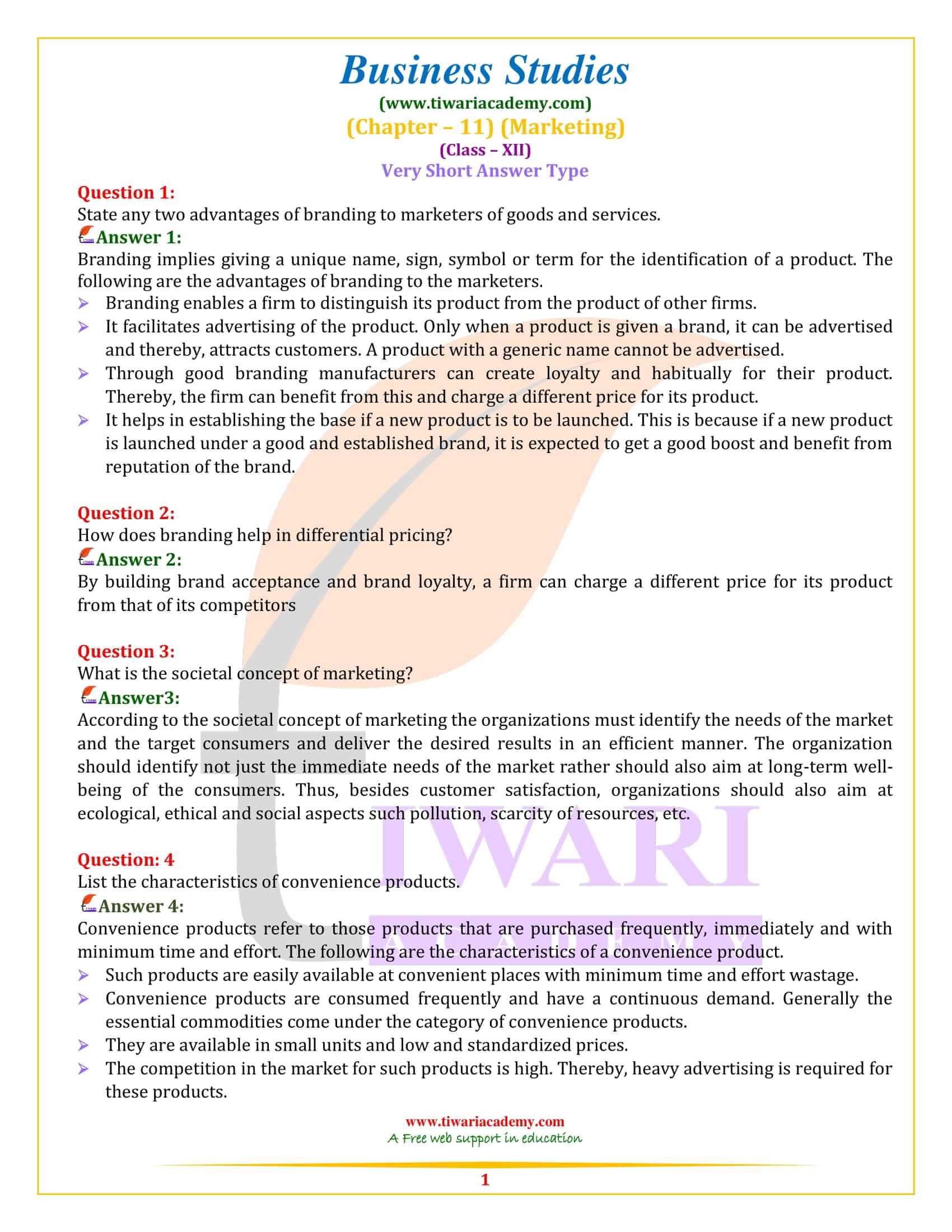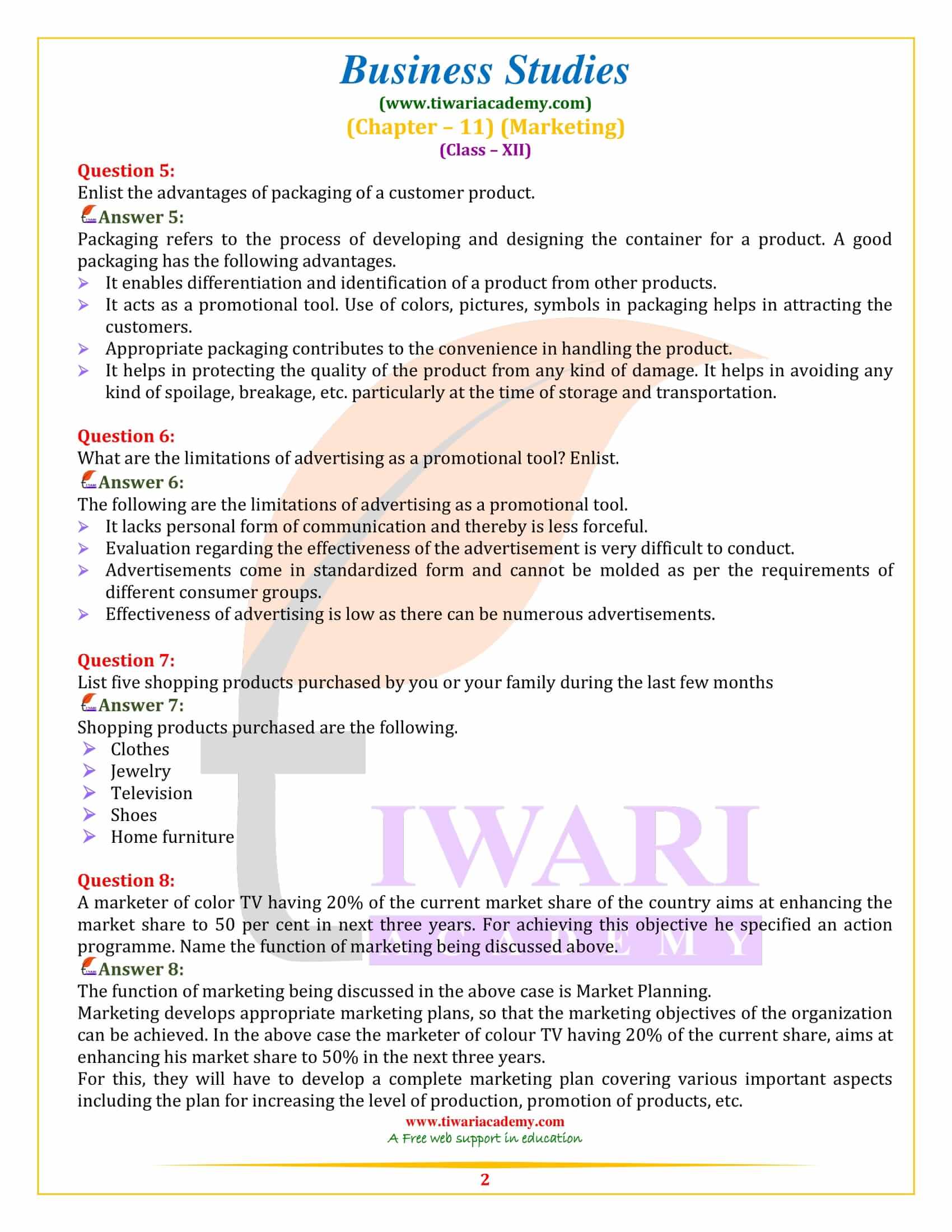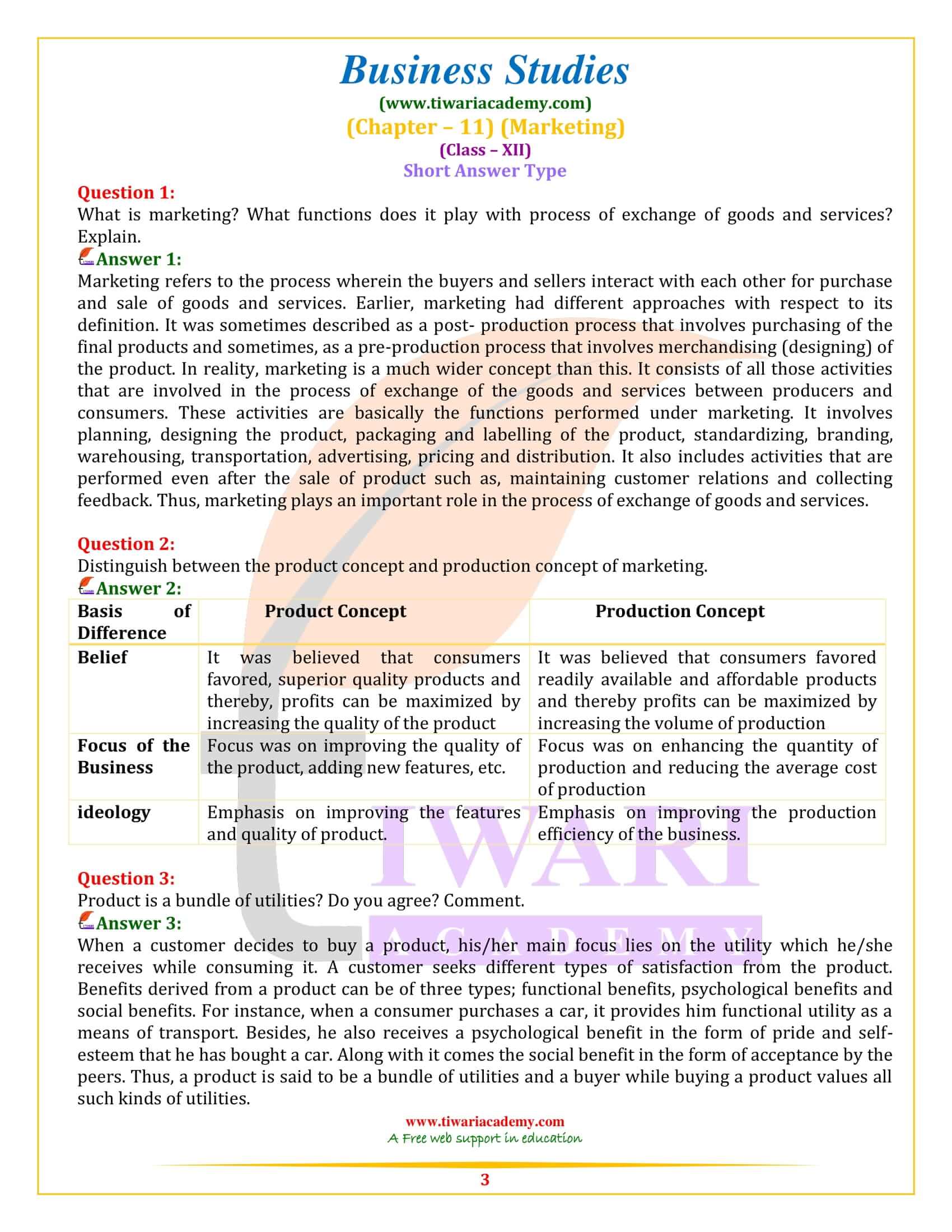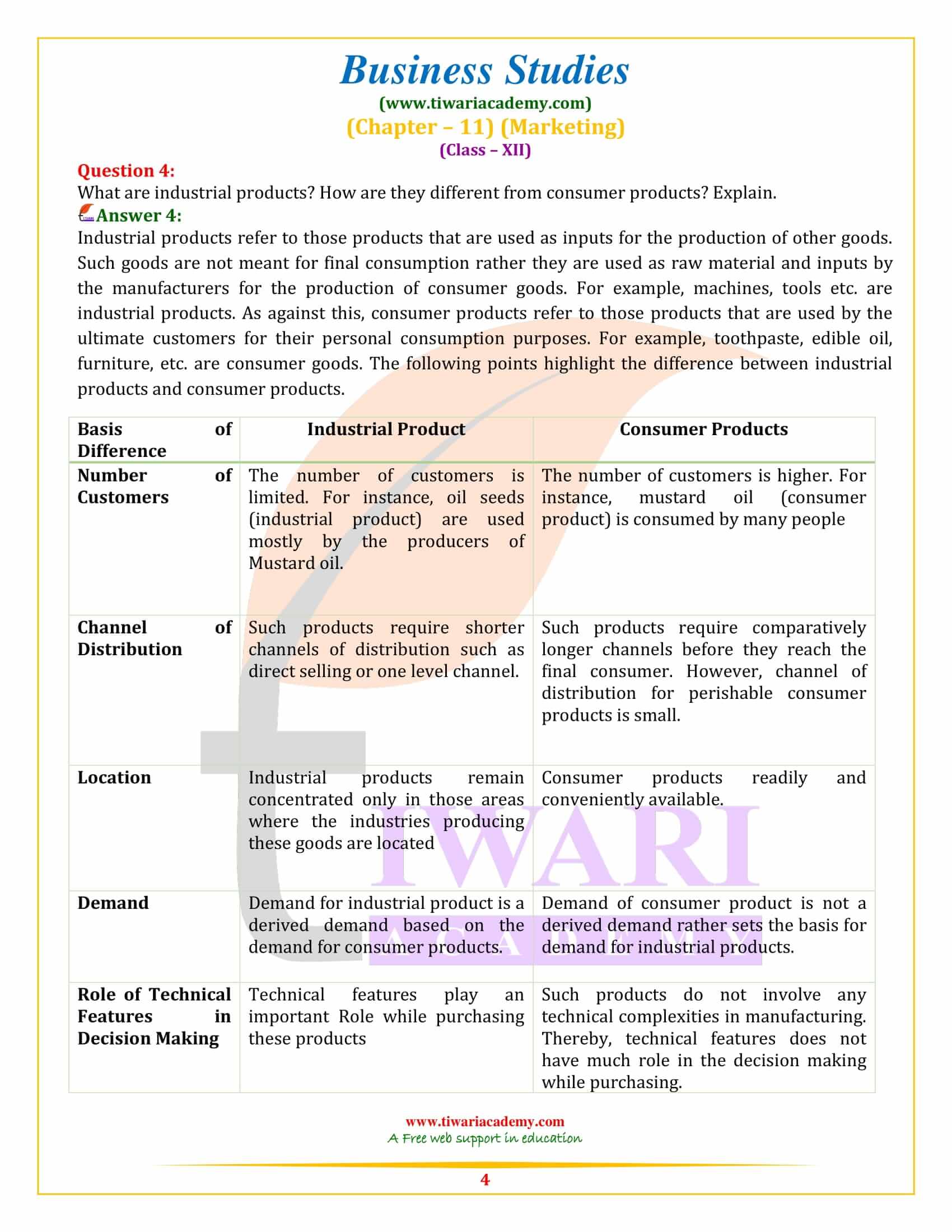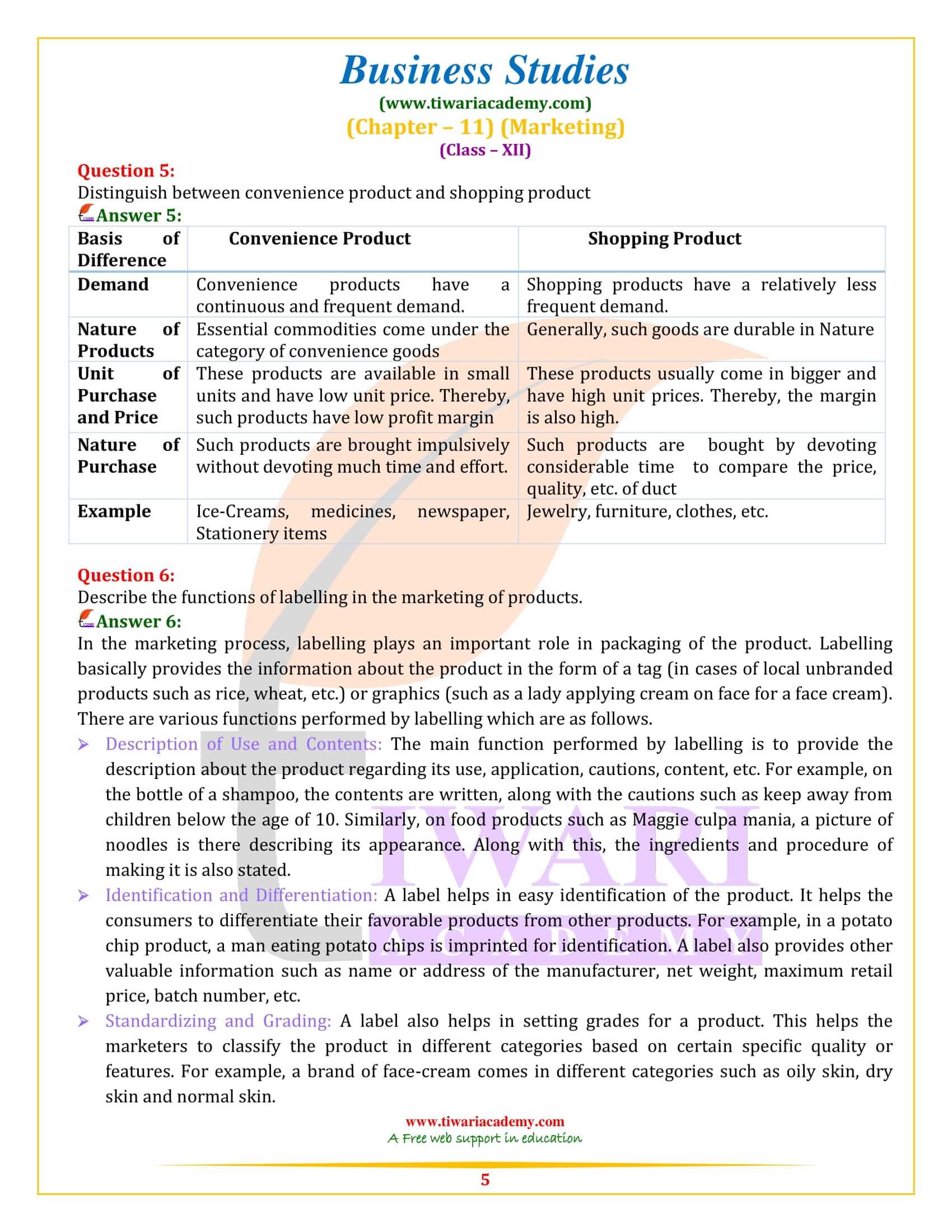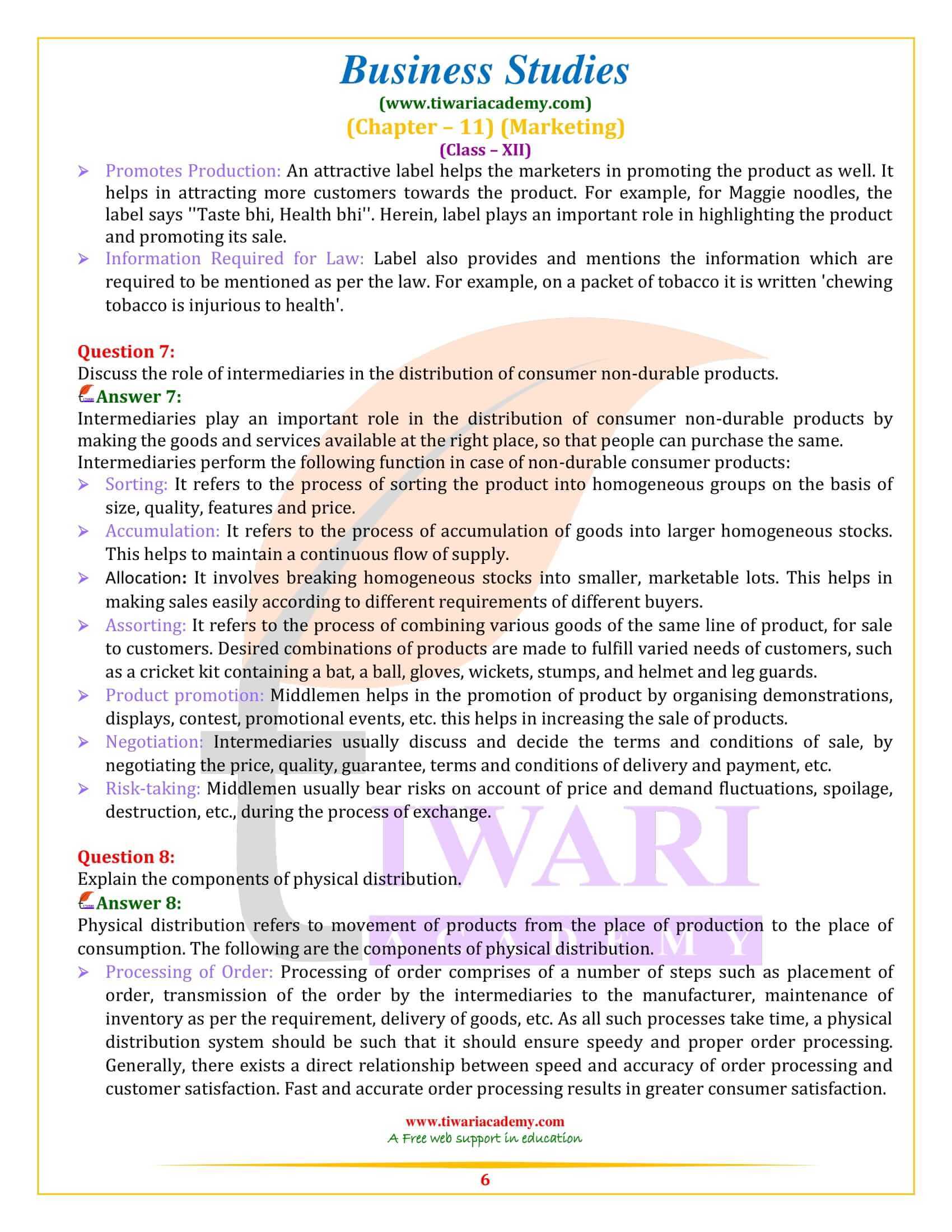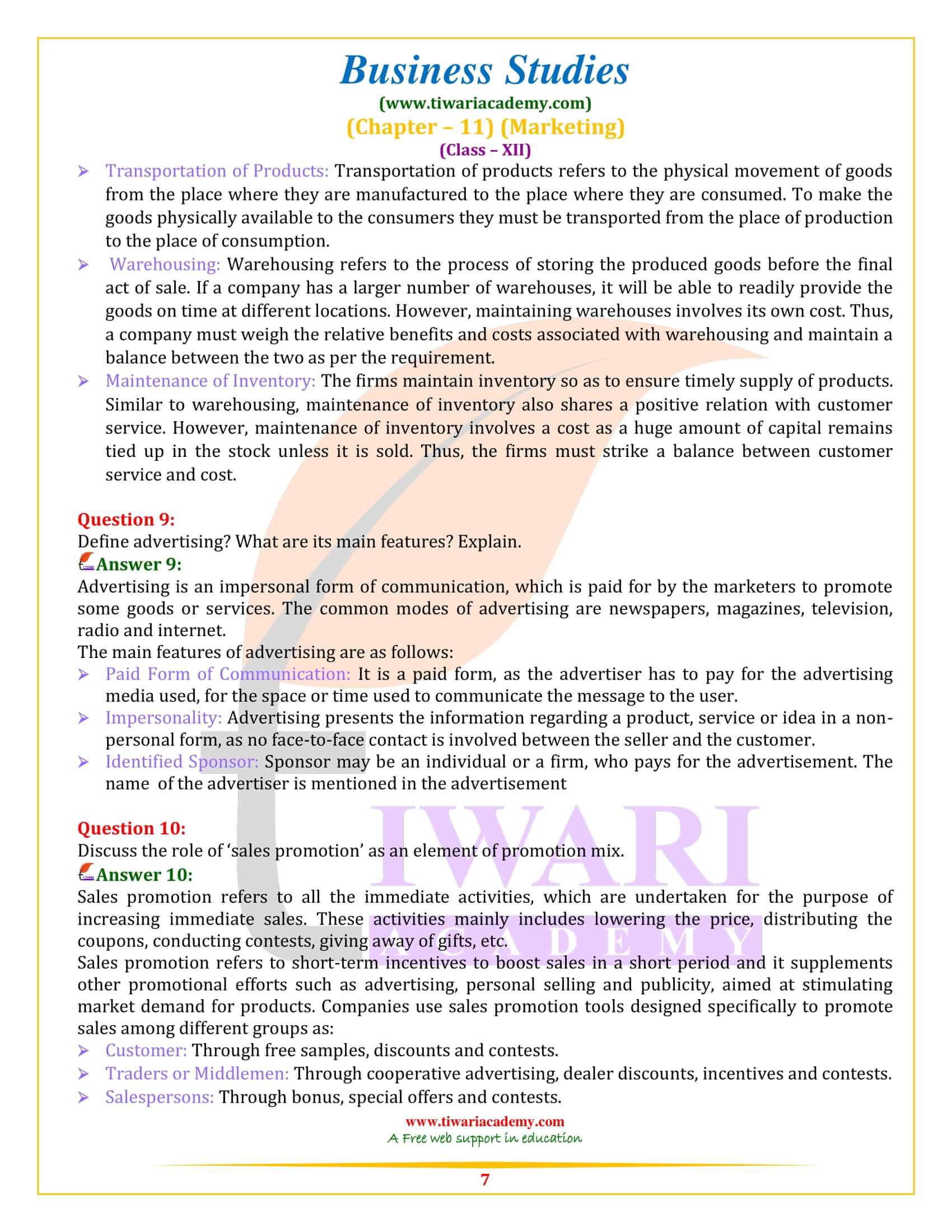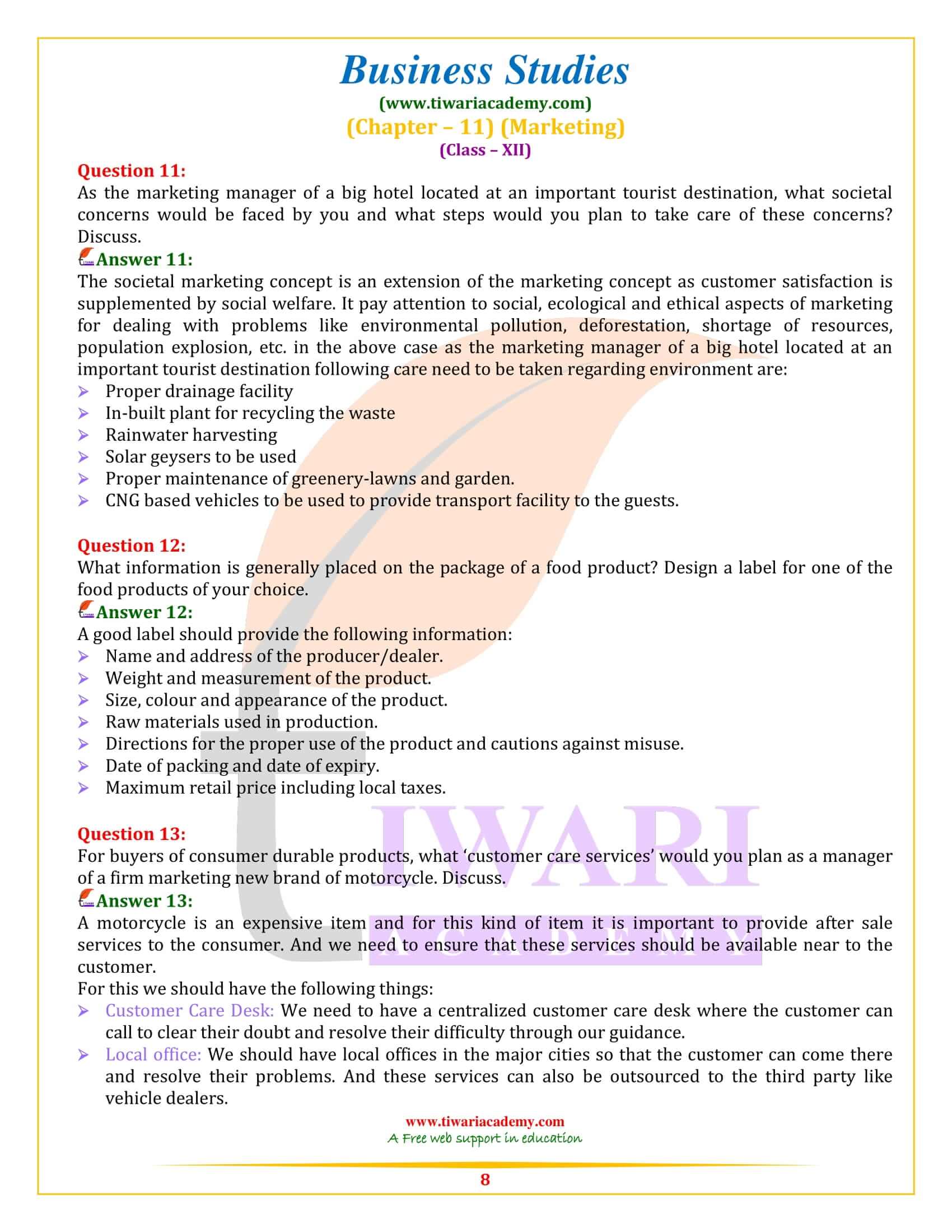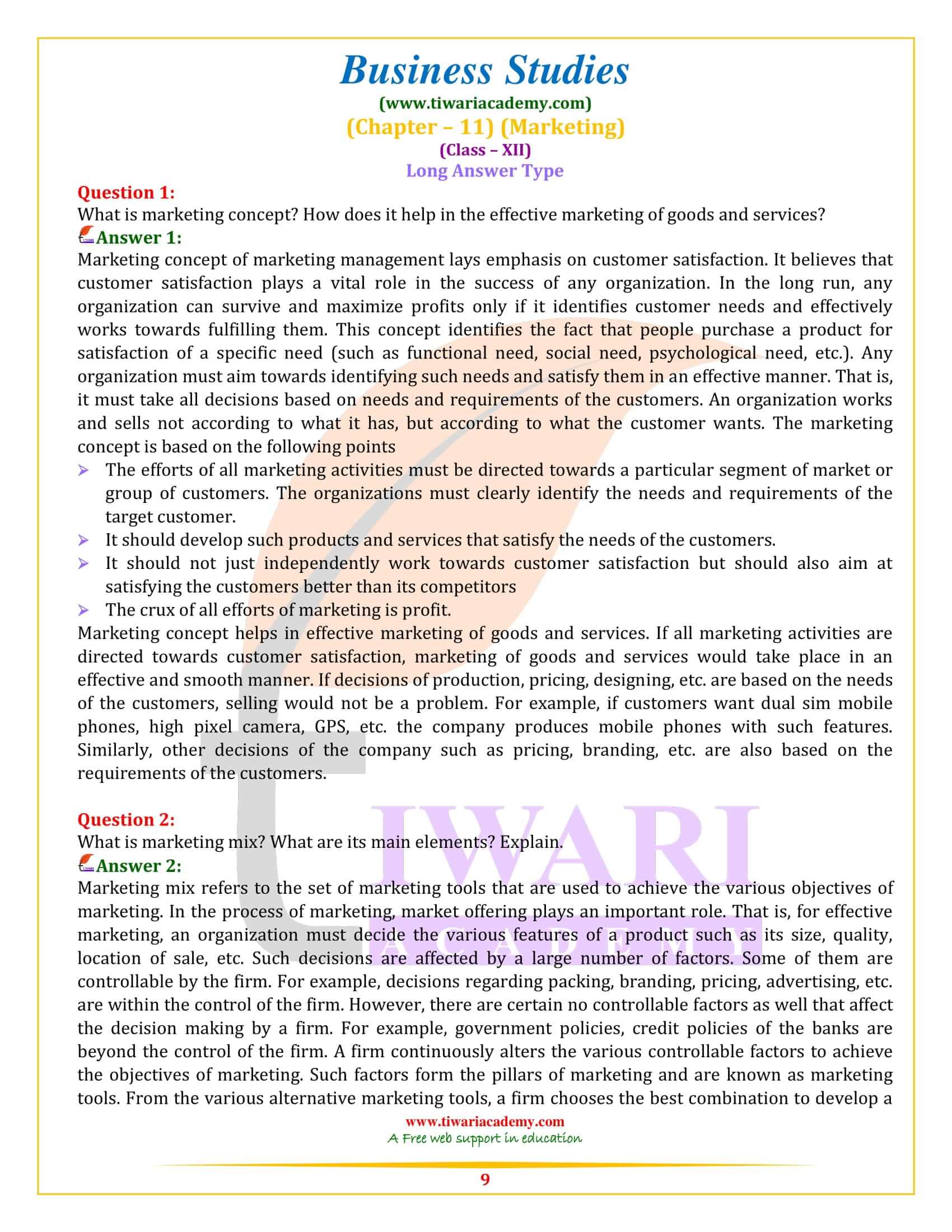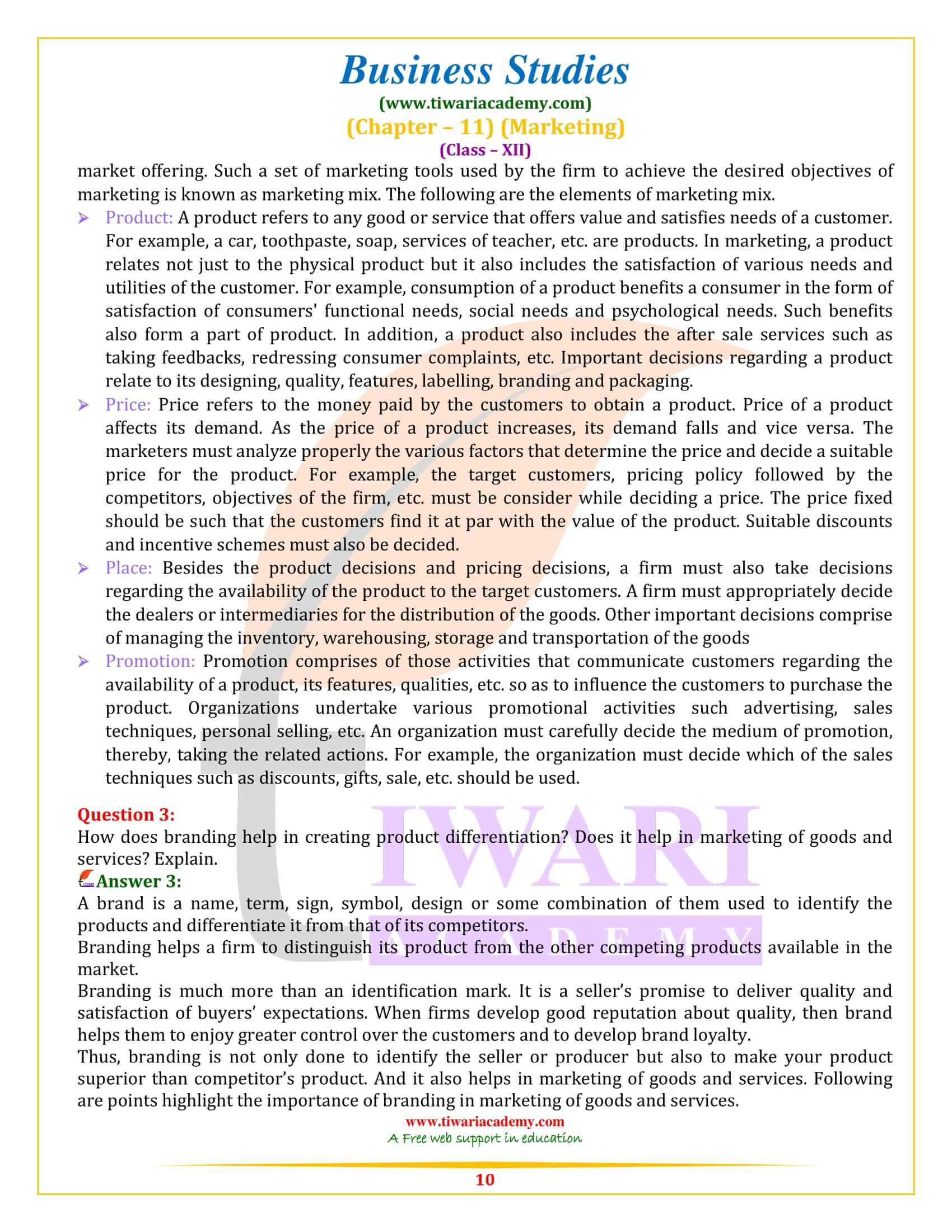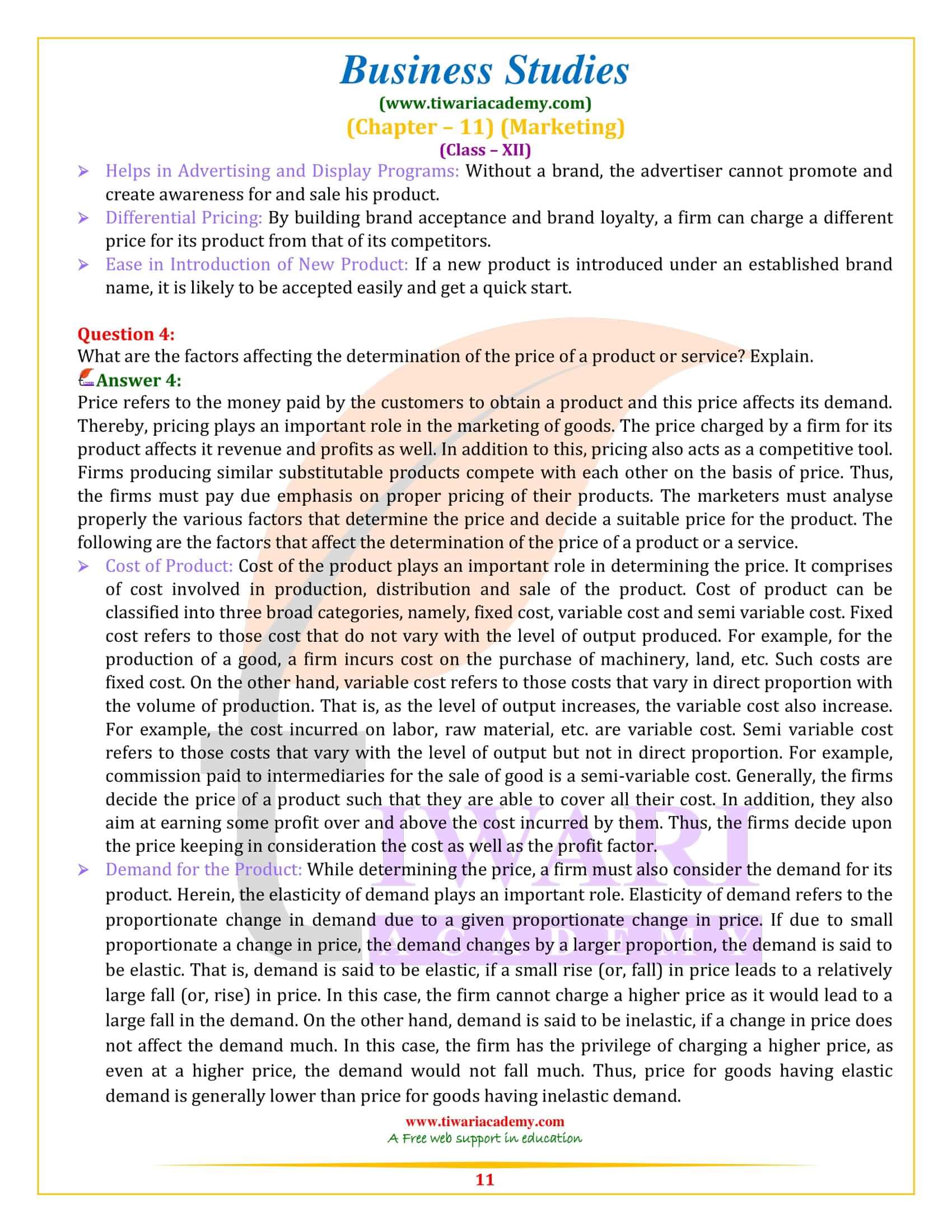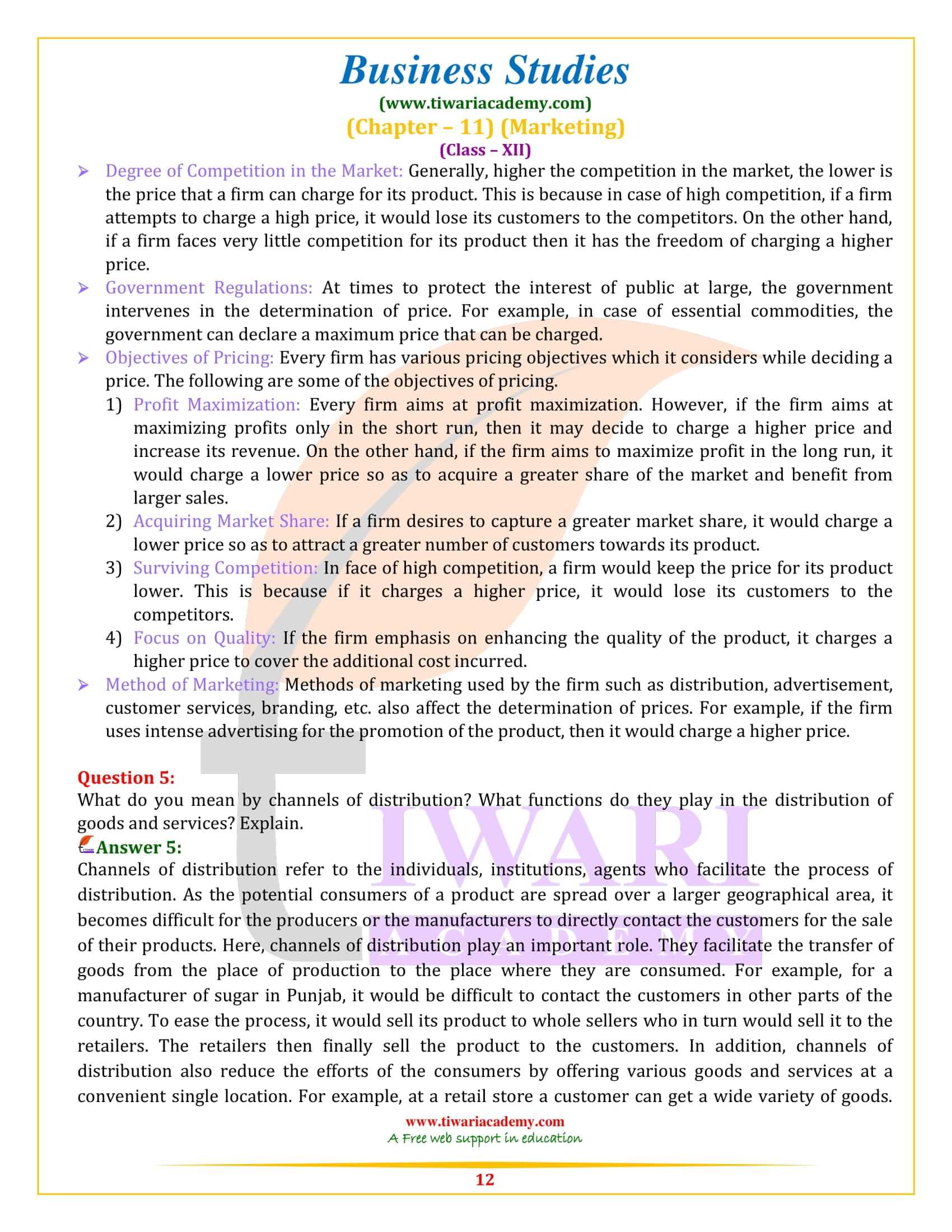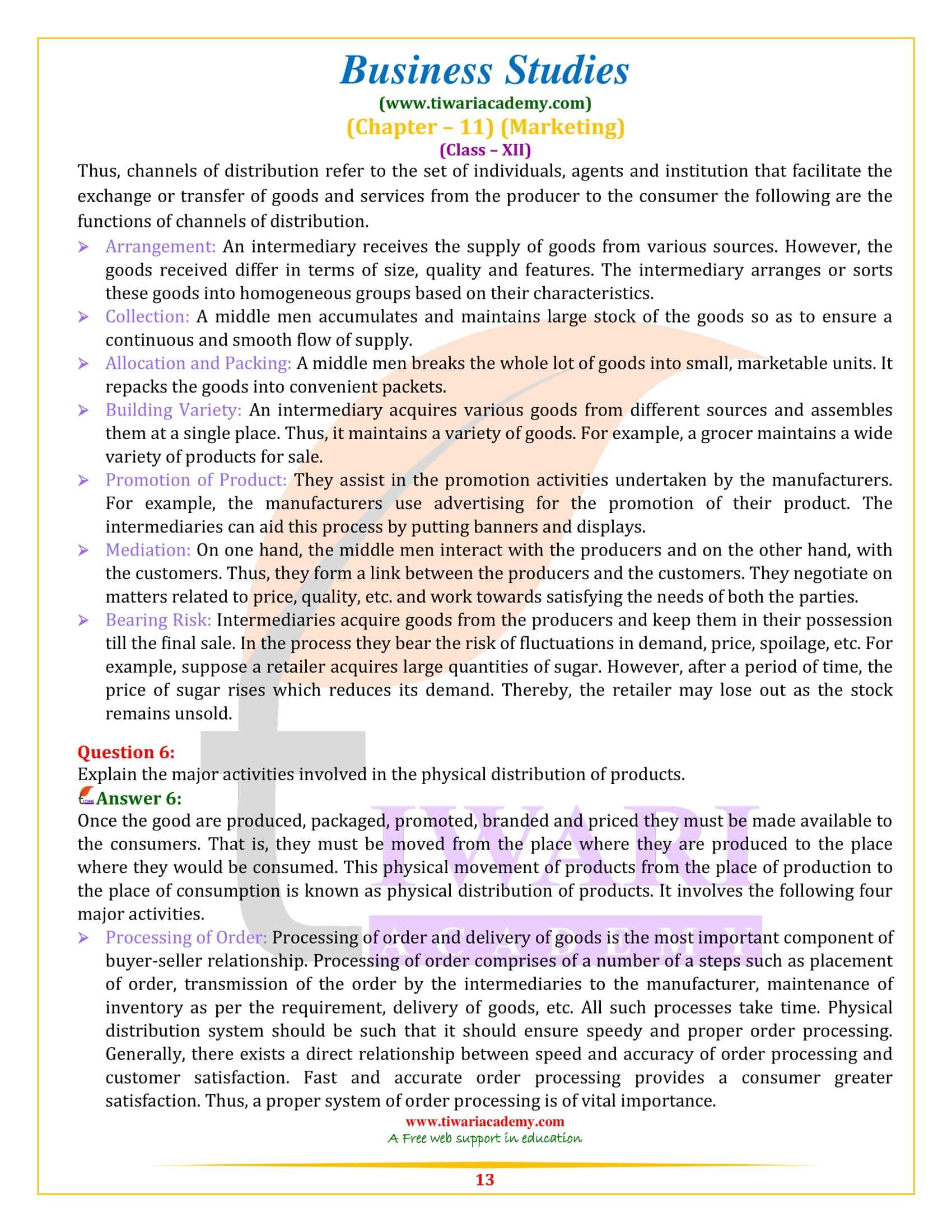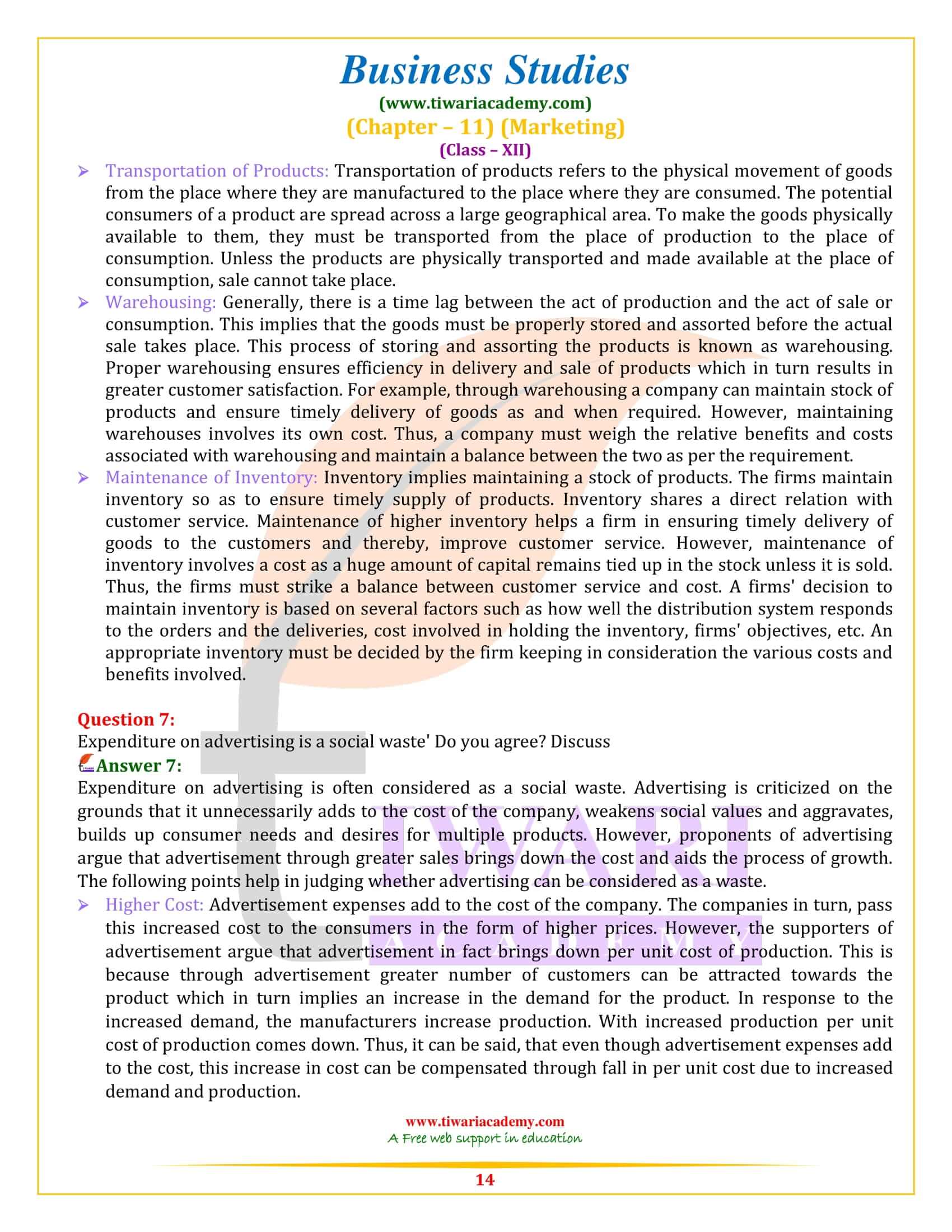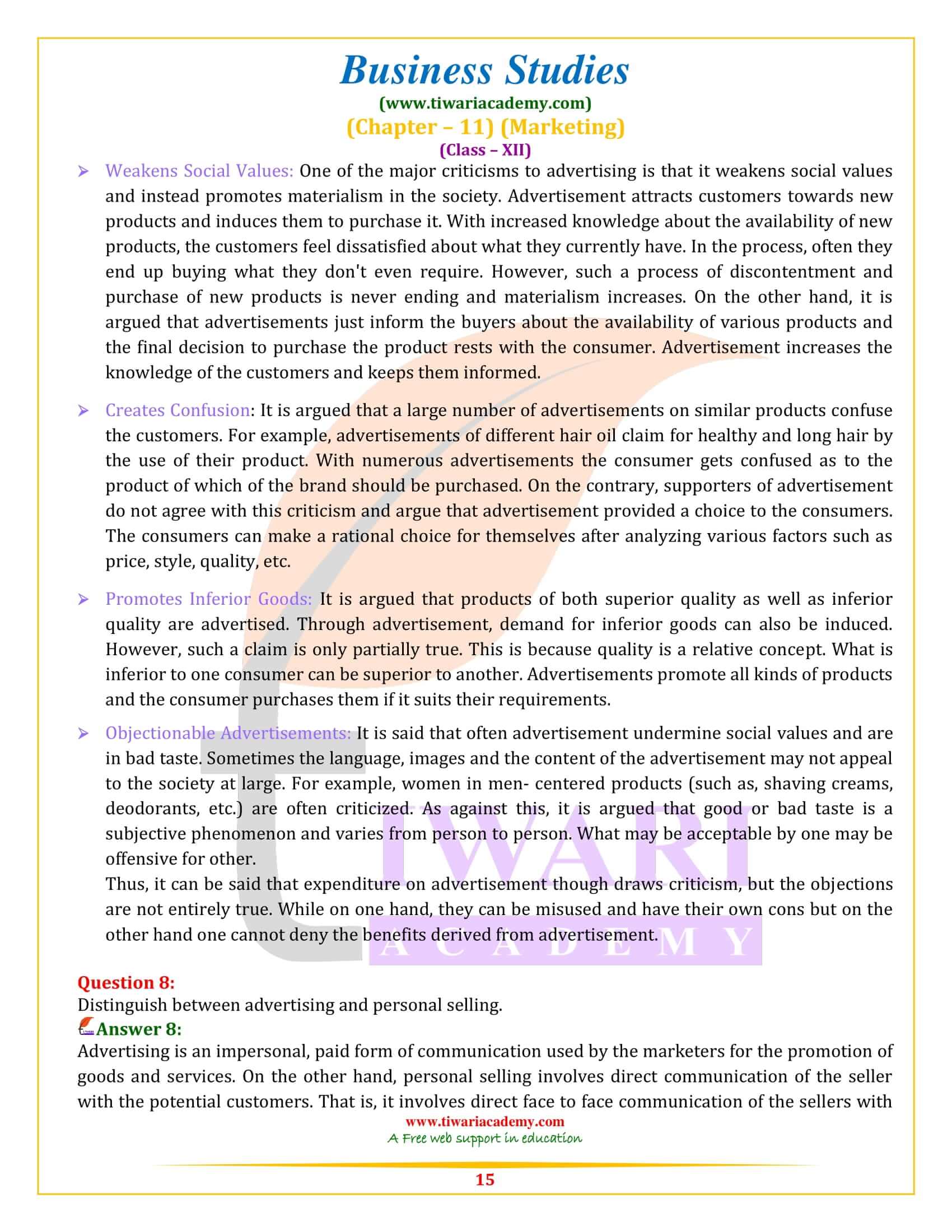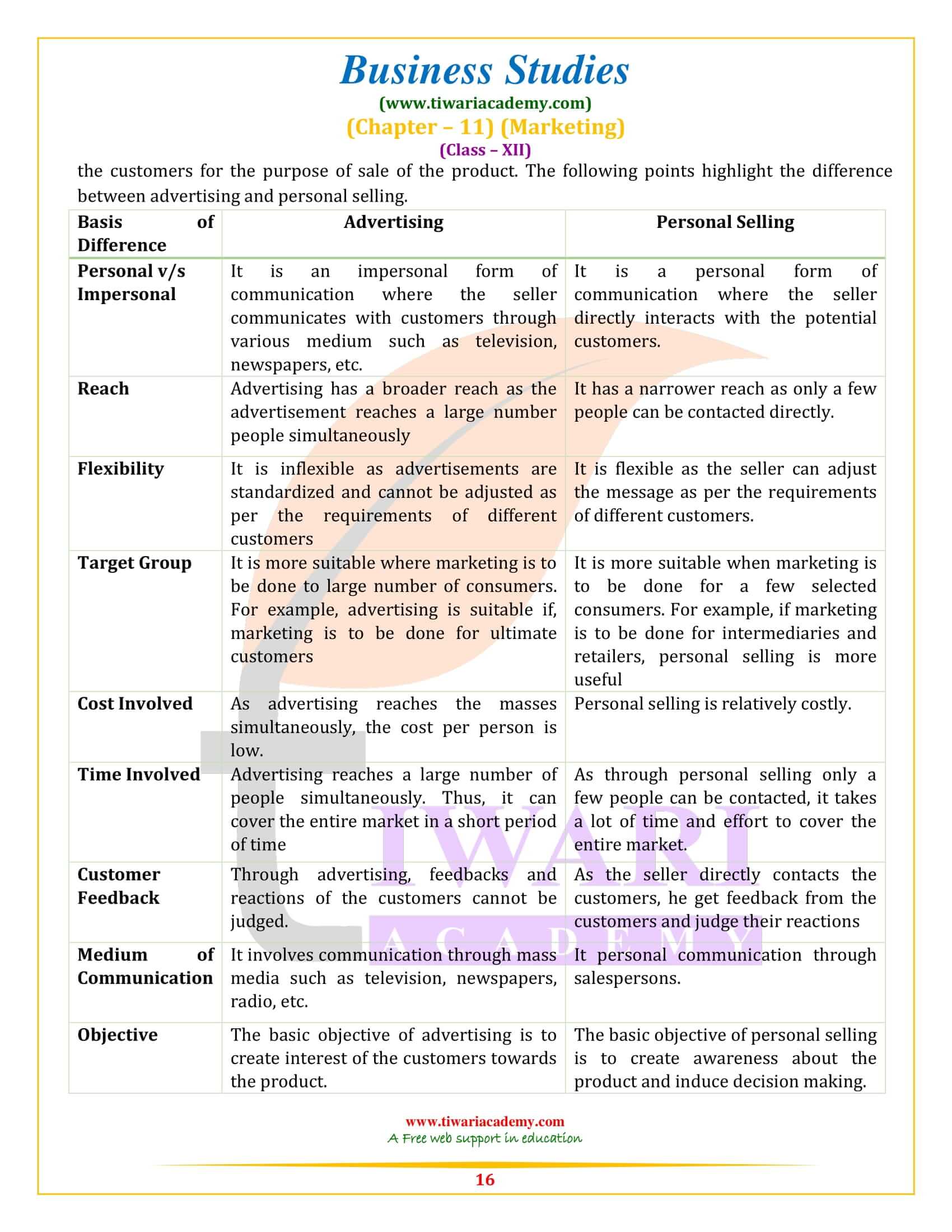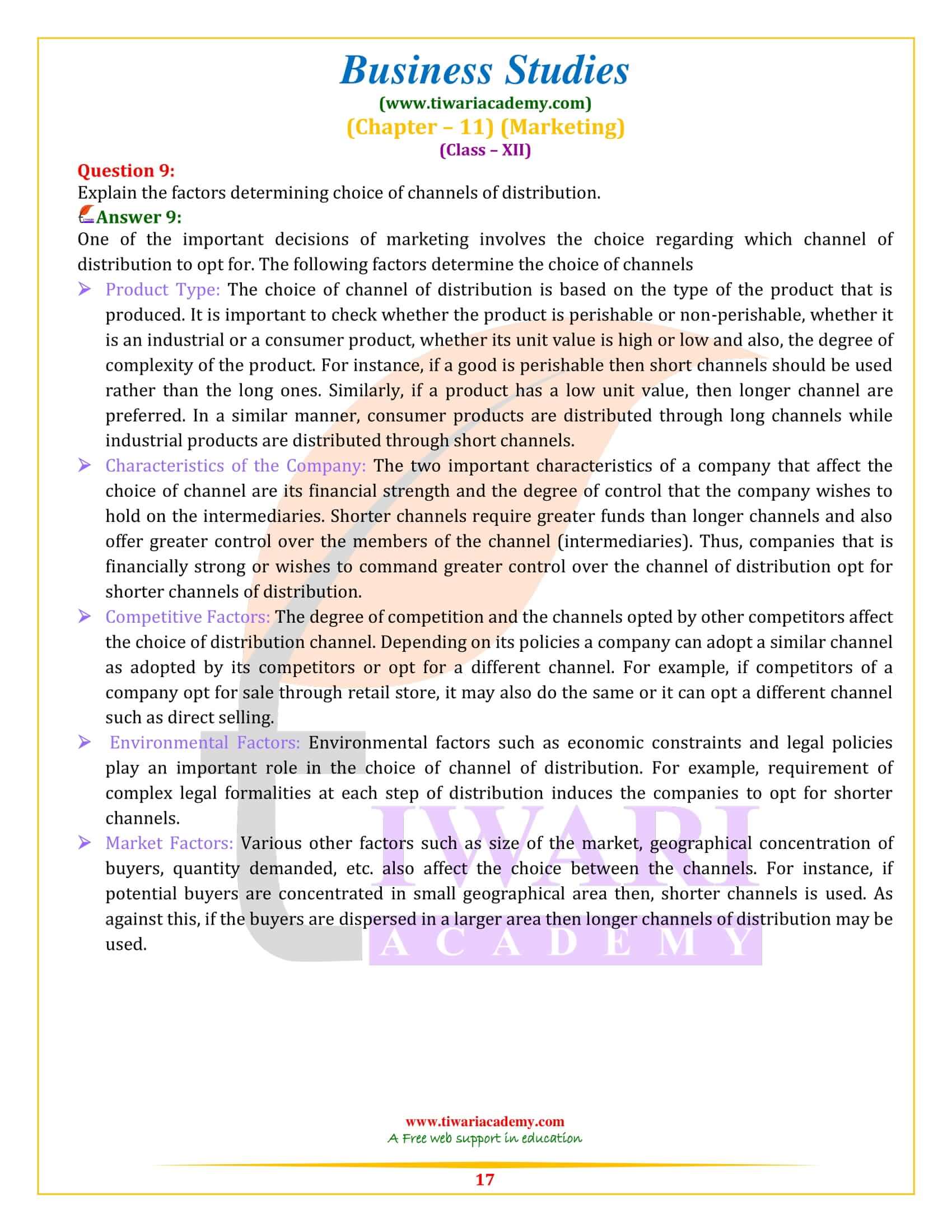NCERT Solutions for Class 12 Business Studies Chapter 11 Marketing Management in English Medium based on latest NCERT Textbooks for CBSE and State boards. Class 12 B St Solutions and MCQ are updated for session 2025-26 free to use online or download.
Viva Questions for Class 12 B.St.
NCERT Solutions for Class 12 Business Studies Chapter 11
Class 12 Business Studies Chapter 11 NCERT Solutions
Very Short Answer Type Questions
State any two advantages of branding to marketers of goods and services.
Branding implies giving a unique name, sign, symbol or term for the identification of a product. The following are the advantages of branding to the marketers.
- Branding enables a firm to distinguish its product from the product of other firms.
- It facilitates advertising of the product. Only when a product is given a brand, it can be advertised and thereby, attracts customers. A product with a generic name cannot be advertised.
- Through good branding manufacturers can create loyalty and habitually for their product. Thereby, the firm can benefit from this and charge a different price for its product.
- It helps in establishing the base if a new product is to be launched. This is because if a new product is launched under a good and established brand, it is expected to get a good boost and benefit from reputation of the brand.
How does branding help in differential pricing?
By building brand acceptance and brand loyalty, a firm can charge a different price for its product from that of its competitors.
What is the societal concept of marketing?
According to the societal concept of marketing the organizations must identify the needs of the market and the target consumers and deliver the desired results in an efficient manner. The organization should identify not just the immediate needs of the market rather should also aim at long-term well-being of the consumers. Thus, besides customer satisfaction, organizations should also aim at ecological, ethical and social aspects such pollution, scarcity of resources, etc.
List the characteristics of convenience products.
Convenience products refer to those products that are purchased frequently, immediately and with minimum time and effort. The following are the characteristics of a convenience product.
- Such products are easily available at convenient places with minimum time and effort wastage.
- Convenience products are consumed frequently and have a continuous demand. Generally the essential commodities come under the category of convenience products.
- They are available in small units and low and standardized prices.
- The competition in the market for such products is high. Thereby, heavy advertising is required for these products.
Enlist the advantages of packaging of a customer product.
Packaging refers to the process of developing and designing the container for a product. A good packaging has the following advantages:
- It enables differentiation and identification of a product from other products.
- It acts as a promotional tool. Use of colors, pictures, symbols in packaging helps in attracting the customers.
- Appropriate packaging contributes to the convenience in handling the product.
- It helps in protecting the quality of the product from any kind of damage. It helps in avoiding any kind of spoilage, breakage, etc. particularly at the time of storage and transportation.
What are the limitations of advertising as a promotional tool? Enlist.
The following are the limitations of advertising as a promotional tool:
- It lacks personal form of communication and thereby is less forceful.
- Evaluation regarding the effectiveness of the advertisement is very difficult to conduct.
- Advertisements come in standardized form and cannot be molded as per the requirements of different consumer groups.
- Effectiveness of advertising is low as there can be numerous advertisements.
List five shopping products purchased by you or your family during the last few months
Shopping products purchased are the following:
- Clothes
- Jewelry
- Television
- Shoes
- Home furniture
A marketer of color TV having 20% of the current market share of the country aims at enhancing the market share to 50 per cent in next three years. For achieving this objective he specified an action programme. Name the function of marketing being discussed above.
The function of marketing being discussed in the above case is Market Planning.
Marketing develops appropriate marketing plans, so that the marketing objectives of the organization can be achieved. In the above case the marketer of colour TV having 20% of the current share, aims at enhancing his market share to 50% in the next three years.
For this, they will have to develop a complete marketing plan covering various important aspects including the plan for increasing the level of production, promotion of products, etc.
Short Answer Type Questions
What is marketing? What functions does it play with process of exchange of goods and services? Explain.
Marketing refers to the process wherein the buyers and sellers interact with each other for purchase and sale of goods and services. Earlier, marketing had different approaches with respect to its definition. It was sometimes described as a post- production process that involves purchasing of the final products and sometimes, as a pre-production process that involves merchandising (designing) of the product. In reality, marketing is a much wider concept than this. It consists of all those activities that are involved in the process of exchange of the goods and services between producers and consumers. These activities are basically the functions performed under marketing. It involves planning, designing the product, packaging and labelling of the product, standardizing, branding, warehousing, transportation, advertising, pricing and distribution. It also includes activities that are performed even after the sale of product such as, maintaining customer relations and collecting feedback. Thus, marketing plays an important role in the process of exchange of goods and services.
Product is a bundle of utilities? Do you agree? Comment.
When a customer decides to buy a product, his/her main focus lies on the utility which he/she receives while consuming it. A customer seeks different types of satisfaction from the product. Benefits derived from a product can be of three types; functional benefits, psychological benefits and social benefits. For instance, when a consumer purchases a car, it provides him functional utility as a means of transport. Besides, he also receives a psychological benefit in the form of pride and self-esteem that he has bought a car. Along with it comes the social benefit in the form of acceptance by the peers. Thus, a product is said to be a bundle of utilities and a buyer while buying a product values all such kinds of utilities.
Describe the functions of labelling in the marketing of products.
In the marketing process, labelling plays an important role in packaging of the product. Labelling basically provides the information about the product in the form of a tag (in cases of local unbranded products such as rice, wheat, etc.) or graphics (such as a lady applying cream on face for a face cream). There are various functions performed by labelling which are as follows.
Description of Use and Contents: The main function performed by labelling is to provide the description about the product regarding its use, application, cautions, content, etc. For example, on the bottle of a shampoo, the contents are written, along with the cautions such as keep away from children below the age of 10. Similarly, on food products such as Maggie culpa mania, a picture of noodles is there describing its appearance. Along with this, the ingredients and procedure of making it is also stated.
Identification and Differentiation: A label helps in easy identification of the product. It helps the consumers to differentiate their favorable products from other products. For example, in a potato chip product, a man eating potato chips is imprinted for identification. A label also provides other valuable information such as name or address of the manufacturer, net weight, maximum retail price, batch number, etc.
Standardizing and Grading: A label also helps in setting grades for a product. This helps the marketers to classify the product in different categories based on certain specific quality or features. For example, a brand of face-cream comes in different categories such as oily skin, dry skin and normal skin.
Promotes Production: An attractive label helps the marketers in promoting the product as well. It helps in attracting more customers towards the product. For example, for Maggie noodles, the label says “Taste bhi, Health bhi”. Herein, label plays an important role in highlighting the product and promoting its sale.
Information Required for Law: Label also provides and mentions the information which are required to be mentioned as per the law. For example, on a packet of tobacco it is written ‘chewing tobacco is injurious to health’.
Discuss the role of intermediaries in the distribution of consumer non-durable products.
-
Intermediaries play an important role in the distribution of consumer non-durable products by making the goods and services available at the right place, so that people can purchase the same.
- Sorting: It refers to the process of sorting the product into homogeneous groups on the basis of size, quality, features and price.
- Accumulation: It refers to the process of accumulation of goods into larger homogeneous stocks. This helps to maintain a continuous flow of supply.
- Allocation: It involves breaking homogeneous stocks into smaller, marketable lots. This helps in making sales easily according to different requirements of different buyers.
- Assorting: It refers to the process of combining various goods of the same line of product, for sale to customers. Desired combinations of products are made to fulfill varied needs of customers, such as a cricket kit containing a bat, a ball, gloves, wickets, stumps, and helmet and leg guards.
- Product promotion: Middlemen helps in the promotion of product by organising demonstrations, displays, contest, promotional events, etc. this helps in increasing the sale of products.
- Negotiation: Intermediaries usually discuss and decide the terms and conditions of sale, by negotiating the price, quality, guarantee, terms and conditions of delivery and payment, etc.
- Risk-taking: Middlemen usually bear risks on account of price and demand fluctuations, spoilage, destruction, etc., during the process of exchange.
Intermediaries perform the following function in case of non-durable consumer products:
Explain the components of physical distribution.
Physical distribution refers to movement of products from the place of production to the place of consumption. The following are the components of physical distribution.
Processing of Order: Processing of order comprises of a number of steps such as placement of order, transmission of the order by the intermediaries to the manufacturer, maintenance of inventory as per the requirement, delivery of goods, etc. As all such processes take time, a physical distribution system should be such that it should ensure speedy and proper order processing. Generally, there exists a direct relationship between speed and accuracy of order processing and customer satisfaction. Fast and accurate order processing results in greater consumer satisfaction.
Transportation of Products: Transportation of products refers to the physical movement of goods from the place where they are manufactured to the place where they are consumed. To make the goods physically available to the consumers they must be transported from the place of production to the place of consumption.
Warehousing: Warehousing refers to the process of storing the produced goods before the final act of sale. If a company has a larger number of warehouses, it will be able to readily provide the goods on time at different locations. However, maintaining warehouses involves its own cost. Thus, a company must weigh the relative benefits and costs associated with warehousing and maintain a balance between the two as per the requirement.
Maintenance of Inventory: The firms maintain inventory so as to ensure timely supply of products. Similar to warehousing, maintenance of inventory also shares a positive relation with customer service. However, maintenance of inventory involves a cost as a huge amount of capital remains tied up in the stock unless it is sold. Thus, the firms must strike a balance between customer service and cost.
Define advertising? What are its main features? Explain.
Advertising is an impersonal form of communication, which is paid for by the marketers to promote some goods or services. The common modes of advertising are newspapers, magazines, television, radio and internet.
The main features of advertising are as follows:
Paid Form of Communication: It is a paid form, as the advertiser has to pay for the advertising media used, for the space or time used to communicate the message to the user.
Impersonality: Advertising presents the information regarding a product, service or idea in a non-personal form, as no face-to-face contact is involved between the seller and the customer.
Identified Sponsor: Sponsor may be an individual or a firm, who pays for the advertisement. The name of the advertiser is mentioned in the advertisement
Long Answer Type Questions
What is marketing concept? How does it help in the effective marketing of goods and services?
Marketing concept of marketing management lays emphasis on customer satisfaction. It believes that customer satisfaction plays a vital role in the success of any organization. In the long run, any organization can survive and maximize profits only if it identifies customer needs and effectively works towards fulfilling them. This concept identifies the fact that people purchase a product for satisfaction of a specific need (such as functional need, social need, psychological need, etc.). Any organization must aim towards identifying such needs and satisfy them in an effective manner. That is, it must take all decisions based on needs and requirements of the customers. An organization works and sells not according to what it has, but according to what the customer wants. The marketing concept is based on the following points
1. The efforts of all marketing activities must be directed towards a particular segment of market or group of customers. The organizations must clearly identify the needs and requirements of the target customer.
2. It should develop such products and services that satisfy the needs of the customers.
3. It should not just independently work towards customer satisfaction but should also aim at satisfying the customers better than its competitors
4. The crux of all efforts of marketing is profit.
Marketing concept helps in effective marketing of goods and services. If all marketing activities are directed towards customer satisfaction, marketing of goods and services would take place in an effective and smooth manner. If decisions of production, pricing, designing, etc. are based on the needs of the customers, selling would not be a problem. For example, if customers want dual sim mobile phones, high pixel camera, GPS, etc. the company produces mobile phones with such features. Similarly, other decisions of the company such as pricing, branding, etc. are also based on the requirements of the customers.
What is marketing mix? What are its main elements? Explain.
Marketing mix refers to the set of marketing tools that are used to achieve the various objectives of marketing. In the process of marketing, market offering plays an important role. That is, for effective marketing, an organization must decide the various features of a product such as its size, quality, location of sale, etc. Such decisions are affected by a large number of factors. Some of them are controllable by the firm. For example, decisions regarding packing, branding, pricing, advertising, etc. are within the control of the firm. However, there are certain no controllable factors as well that affect the decision making by a firm. For example, government policies, credit policies of the banks are beyond the control of the firm. A firm continuously alters the various controllable factors to achieve the objectives of marketing. Such factors form the pillars of marketing and are known as marketing tools. From the various alternative marketing tools, a firm chooses the best combination to develop a market offering. Such a set of marketing tools used by the firm to achieve the desired objectives of marketing is known as marketing mix. The following are the elements of marketing mix.
Product: A product refers to any good or service that offers value and satisfies needs of a customer. For example, a car, toothpaste, soap, services of teacher, etc. are products. In marketing, a product relates not just to the physical product but it also includes the satisfaction of various needs and utilities of the customer. For example, consumption of a product benefits a consumer in the form of satisfaction of consumers’ functional needs, social needs and psychological needs. Such benefits also form a part of product. In addition, a product also includes the after sale services such as taking feedback, redressing consumer complaints, etc. Important decisions regarding a product relate to its designing, quality, features, labelling, branding and packaging.
Price: Price refers to the money paid by the customers to obtain a product. Price of a product affects its demand. As the price of a product increases, its demand falls and vice versa. The marketers must analyze properly the various factors that determine the price and decide a suitable price for the product. For example, the target customers, pricing policy followed by the competitors, objectives of the firm, etc. must be consider while deciding a price. The price fixed should be such that the customers find it at par with the value of the product. Suitable discounts and incentive schemes must also be decided.
Place: Besides the product decisions and pricing decisions, a firm must also take decisions regarding the availability of the product to the target customers. A firm must appropriately decide the dealers or intermediaries for the distribution of the goods. Other important decisions comprise of managing the inventory, warehousing, storage and transportation of the goods
Promotion: Promotion comprises of those activities that communicate customers regarding the availability of a product, its features, qualities, etc. so as to influence the customers to purchase the product. Organizations undertake various promotional activities such advertising, sales techniques, personal selling, etc. An organization must carefully decide the medium of promotion, thereby, taking the related actions. For example, the organization must decide which of the sales techniques such as discounts, gifts, sale, etc. should be used.
FAQs
Who is known as father of marketing management as per chapter 11 of 12 B. St.?
Phillip Kotler. In fact, this book is prescribed for all students studying marketing management. However, as a student of class 12 and for examination purpose you should confine your study to textbooks and good websites/ reference books.
Does the chapter 11 of class 12 Business Studies help us to market our product in real life situations?
No, This chapter provides basic knowledge about marketing and marketing mix. Of course, you will get to know some useful information as to how companies market their products.
Can a student select class 12 B. St. chapter 11 for project work?
Certainly, among the four topics mentioned by CBSE board, this is one of the topics which students can choose as part of their project work.
What are the important questions from chapter 11 of 12th Business Studies?
You can always expect a question on the benefits and limitation on advertising, product mix and its components.
